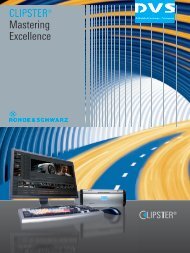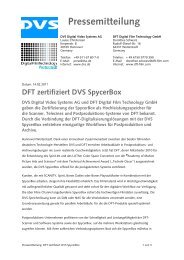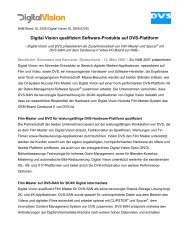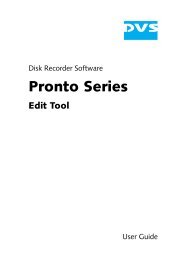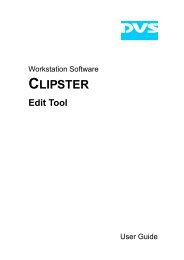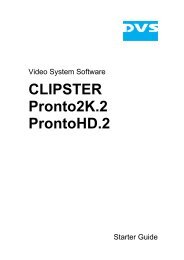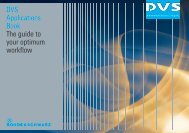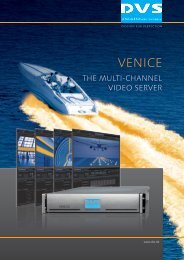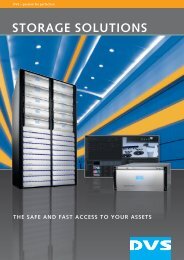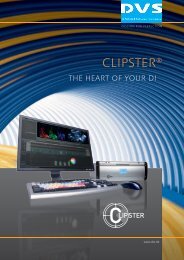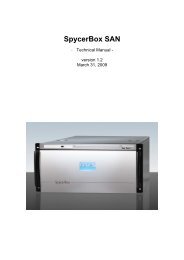You also want an ePaper? Increase the reach of your titles
YUMPU automatically turns print PDFs into web optimized ePapers that Google loves.
Rohde & Schwarz <strong>DVS</strong> GmbH | www.dvs.de<br />
Application Note<br />
File-based broadcasting with VENICE – The Media Production Hub<br />
CASE SUMMARY<br />
Need: A major US East Coast broadcast network was looking for a solution that would enable them to orchestrate multiple<br />
business units to handle the increased demand to deliver content with a very fast turnaround. Moreover, systems were<br />
needed that would allow efficient ingest, content preparation, transcoding and playback – while at the same time being<br />
able to switch between different video resolutions and codecs. They also required a system that offered complete<br />
automation support. All in all, the new workflows had to be more reliable, flexible and future-ready.<br />
Solution: Innovative <strong>DVS</strong> equipment is at the heart of the new infrastructure. Six Media Production Hubs VENICE, a <strong>DVS</strong>-SAN<br />
with 100 TB as well the content control software Spycer® helped the broadcaster to successfully transition to file-based<br />
workflows.<br />
Introduction<br />
As broadcast workflows evolve into tapeless file-based<br />
workflows, the demand on broadcast equipment has<br />
grown significantly. The following paper describes the<br />
innovative, file-based workflow implemented at a major<br />
US East Coast broadcast network using the <strong>DVS</strong> systems<br />
VENICE and <strong>DVS</strong>-SAN. The VENICE systems with their<br />
ability to handle a multitude of codecs and video help the<br />
network achieve cutting-edge, cost effective workflow.<br />
The <strong>DVS</strong>-SAN solution allows the consolidation of the<br />
storage infrastructure with an extremely high performance<br />
central storage that dramatically improves the workflow<br />
with real-time sharing of content between disparate<br />
equipment in the broadcast chain.<br />
Requirements<br />
There were multiple business units at the broadcaster that<br />
had to handle increased demand to deliver content in<br />
different formats with very tight turnaround. The<br />
broadcaster was looking for systems that would enable<br />
efficient ingest, content preparation, transcoding and<br />
playback which could easily switch between different<br />
video resolutions and codecs. They were also looking to<br />
streamline and consolidate their storage, allowing their<br />
users to share content across the network. They also<br />
required a system that offered complete automation<br />
support and media management. Last but not least, a<br />
future-ready solution that would allow them to use and<br />
support new codecs in the future was required.
Rohde & Schwarz <strong>DVS</strong> GmbH | www.dvs.de<br />
Original Infrastructure<br />
The original infrastructure at the broadcaster consisted of<br />
systems from different vendors each with its own limited<br />
codec support and its own proprietary storage. They had<br />
very limited ways to get content in and out of the systems.<br />
This resulted in increased transfer times and needless<br />
movement of files between the systems. Managing the<br />
infrastructure and storage space was increasingly complex<br />
as more servers were brought online.<br />
Solution<br />
VENICE – The Media Production Hub VENICE from<br />
Rohde & Schwarz <strong>DVS</strong> GmbH enables real-time capture<br />
and playout of popular broadcast formats like Avid<br />
DNxHD®, Panasonic AVC-Ultra®, DVCPRO®, Sony<br />
XDCAM® and Apple ProRes 422 material. Equipped with a<br />
vast feature set, VENICE includes four independent<br />
channels, run-down lists, intelligent global presets and a<br />
sophisticated transcoding and transwrapping engine.<br />
Positioned as the core of a distribution environment,<br />
VENICE provides fast, consistent workflows with both<br />
compressed and uncompressed video formats. The entire<br />
workflow is built around the VENICE solution bridging the<br />
video and the data world seamlessly. Content coming in<br />
as baseband video stream is converted to files in the<br />
required format easily while preserving all the VANC<br />
metadata and audio.<br />
Spycer® – The innovative Spycer® content control<br />
software enables managing extremely large volumes of<br />
data and video content. SpycerNet is a transparent<br />
network that makes the contents of all connected systems<br />
available for viewing and editing and eliminates the chaos<br />
to automatically provide an overview of the contents in all<br />
storage systems and workstations. Spycer® removes the<br />
uncertainty of finding data in complex networks. An<br />
extensive set of search parameters helps you find image<br />
data, video and audio clips, and metadata with<br />
confidence. Search external drives even when they are<br />
Copyright © 2012, all contents by Rohde & Schwarz <strong>DVS</strong> GmbH. Specifications<br />
and data are subject to change without notice. Some features may be part of<br />
optional or future packages. All trademarks used herein, whether recognized or<br />
not, are the properties of their respective owners.<br />
disconnected. The intelligent <strong>DVS</strong> data manager gives you<br />
a complete overview of all storage components in your<br />
SpycerNet. Spycer® supports multiple MXF variants<br />
typically used in broadcast workflows with codecs like<br />
DVCPRO®, XDCAM® and Avid DNxHD®.<br />
<strong>DVS</strong>-SAN – The custom-built Storage Area Network<br />
(SAN) supports a wide variety of data rates: From 600<br />
MB/s to 10 GB/s and more. The <strong>DVS</strong>-SAN's modular<br />
architecture enables the addition of storage clusters to<br />
yield even higher data rates and a larger number of parallel<br />
video streams.<br />
The <strong>DVS</strong>-SAN storage system is built to sustain these data<br />
rates continuously, not just in short peaks. The <strong>DVS</strong>-SAN<br />
sports a completely open architecture – it is not a<br />
proprietary, insular solution. Whether working with<br />
compressed or uncompressed material in SD, HD, 2K or<br />
even 4K, all connected clients can direct access digital film<br />
and video data on the <strong>DVS</strong>-SAN at sustained data rates.<br />
Moreover the <strong>DVS</strong>-SAN enables multiple workstations to<br />
access the stored material simultaneously across multiple<br />
operating systems. Bandwidth-intensive data streams can<br />
be accessed in parallel – and in many cases faster than<br />
real-time. Process data even while capturing. This results<br />
in a very collaborative workflow without users wasting<br />
time transferring content between their workstations.<br />
One of the other important requirement for this<br />
broadcaster was the reliability and 24/7 availability. So the<br />
customized solution was engineered with a very high level<br />
of reliability. The storage was configured using RAID-6<br />
and multiple metadata servers. The system allows<br />
workstations to access the data over Fibre Channel or<br />
Ethernet connectivity. Engineered to support up to 800<br />
million files and high-speed content sharing, the <strong>DVS</strong>-SAN<br />
offers the perfect solution to maintain rapid growth of file<br />
data.
Rohde & Schwarz <strong>DVS</strong> GmbH | www.dvs.de<br />
Workflow<br />
The workflow was designed around six VENICE systems<br />
connected to a 100 TB <strong>DVS</strong>-SAN over a Fibre Channel<br />
infrastructure. The six VENICE systems provide 24<br />
channels for ingest or playout across the entire workflow.<br />
The content coming in from tapes or satellite sources are<br />
ingested using the VENICE systems. The VENICE systems<br />
can be controlled either using the GUI or via VDCP. Preset<br />
configurations saved in the VENICE systems can be<br />
recalled in a snap to make it easy for the end users to<br />
quickly set up the systems for ingest.<br />
Video, audio and metadata are efficiently ingested into a<br />
wide variety of formats. In this particular case, the<br />
broadcaster utilizes GXF and MXF formats primarily. The<br />
Media Production Hub manages native real-time capturing<br />
and simultaneously scaling different formats. All content is<br />
available within the network immediately. Files coming<br />
from the outside can be either ingested directly or<br />
transcoded and ingested into the <strong>DVS</strong>-SAN.<br />
The <strong>DVS</strong>-SAN is configured as the central storage for<br />
production. Thanks to its fault-tolerant design, the <strong>DVS</strong>-<br />
SAN ensures smooth production providing with the<br />
greatest possible reliability. With up to 6 GB/s of sustained<br />
bandwidth the <strong>DVS</strong>-SAN can handle hundreds of real-time<br />
streams. All the VENICE systems ingest directly onto the<br />
<strong>DVS</strong>-SAN system. The content is available on every other<br />
system instantaneously. There is no transferring of content<br />
from one workstation to another. The <strong>DVS</strong>-SAN uses the<br />
Quantum StorNext file system that allows Windows®,<br />
Linux® and Mac® clients to mount and share the common<br />
storage pool.<br />
Once the content is available on the <strong>DVS</strong>-SAN, the<br />
Spycer® content control system catalogues the data and<br />
keeps track of all the metadata this way making it instantly<br />
searchable across the entire network.<br />
Copyright © 2012, all contents by Rohde & Schwarz <strong>DVS</strong> GmbH. Specifications<br />
and data are subject to change without notice. Some features may be part of<br />
optional or future packages. All trademarks used herein, whether recognized or<br />
not, are the properties of their respective owners.<br />
Other systems on the network including third-party<br />
transcoders, Quality Control systems etc. all connect to<br />
the <strong>DVS</strong>-SAN to utilize the content. The automation<br />
systems orchestrates various processes like Quality<br />
Control, transcode etc. Six file servers are connected to<br />
the <strong>DVS</strong>-SAN to allow various other systems to access the<br />
content over the network.<br />
The Spycer® web services allow the automation system to<br />
catalogue and keep track of the ingested data. Using<br />
SOAP services, the automation system even moves the<br />
content at the appropriate time to the on-air playout<br />
systems for playback of the content. The Spycer® also<br />
allows remote systems with only Ethernet connection to<br />
search, QC and move the content.<br />
Moreover, the automation system also uses the Spycer®<br />
web services to trigger the proxy generation. Remote<br />
systems, connected to the <strong>DVS</strong>-SAN over Ethernet<br />
through the <strong>DVS</strong> file servers, can use the proxy files to QC<br />
the content.<br />
The <strong>DVS</strong> Avid® appliance server offers a server appliance<br />
connected to the VENICE base system and enables direct<br />
signal ingest via HD-SDI. In this configuration, up to four<br />
channels can be ingested in parallel together with<br />
simultaneous proxy file generation. The transcoding mode<br />
can convert all media supported by VENICE, such as<br />
Apple QuickTime® with Apple ProRes422, MPEG-2<br />
program streams or even uncompressed file sequences<br />
directly into Avid® editing environment. All files are<br />
immediately checked in into Interplay® and will be ready<br />
for editing on a connected Media Composer® within<br />
seconds. All ingest operations support "edit while write",<br />
so that you may start editing immediately, regardless of<br />
whether the source is an SDI signal, a P2 or XDCAM®<br />
media or an uncompressed file sequence.<br />
The <strong>DVS</strong> VENICE system has powerful transcoding and<br />
transwrapping capabilities that allow the network to<br />
transcode the content into various deliverables.
Rohde & Schwarz <strong>DVS</strong> GmbH | www.dvs.de<br />
Benefits<br />
� Support for a wide variety of video/audio file formats<br />
� All relevant broadcast codecs such as Sony XDCAM® HD, Panasonic AVC-Ultra®,<br />
Avid DNxHD®, Apple ProRes 422, MPEG-2, etc.<br />
� Numerous file formats like MXF OP-Atom, MXF OP-1a, QuickTime®, TGA, TIF, DPX<br />
� Comprehensive feature set (playlists, transcoding)<br />
� Flexibility: complete openness to storage architecture<br />
� Multi-format capability: SD/HD<br />
� Integrated scaler for real-time up- and downscaling<br />
� Simultaneous proxy file generation<br />
� Easy integration into existing infrastructures<br />
Copyright © 2012, all contents by Rohde & Schwarz <strong>DVS</strong> GmbH. Specifications<br />
and data are subject to change without notice. Some features may be part of<br />
optional or future packages. All trademarks used herein, whether recognized or<br />
not, are the properties of their respective owners.





